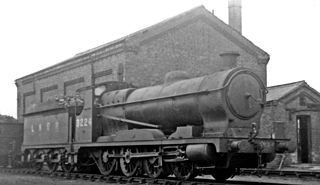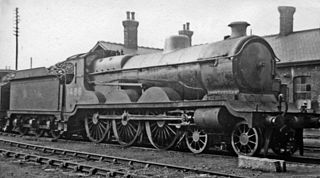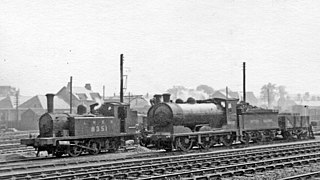John George Robinson CBE, was an English railway engineer, and was chief mechanical engineer of the Great Central Railway from 1900 to 1922.
The London and North Eastern Railway (LNER) produced several classes of locomotive, mostly to the designs of Nigel Gresley, characterised by a three-cylinder layout with a parallel boiler and round-topped firebox. It produced the most famous locomotive of its day, 4468 'Mallard', the holder of the world steam locomotive speed record. It also built the world-famous 4472 'Flying Scotsman'. However, its locomotive inheritance was much greater than just the 'A4 Class', it also produced highly successful mixed-traffic and freight designs.

The London and North Eastern Railway (LNER) Class O4 initially consisted of the 131 ex-Great Central Railway (GCR) Class 8K 2-8-0 steam locomotives acquired on grouping in 1923. The engines were designed by John G. Robinson and built at the GCR's Gorton Locomotive Works, Manchester.

The GER Class L77, LNER Class N7, is a class of 0-6-2T steam locomotives. They were designed by Alfred John Hill of the Great Eastern Railway and introduced in 1915. The design was perpetuated by Nigel Gresley of the LNER after the 1923 grouping. 134 were built and one example is preserved.

The London and North Eastern Railway (LNER) D40 class is a type of 4-4-0 steam locomotive inherited from the Great North of Scotland Railway (GNSR). It consisted of GNSR class V and GNSR class F. The two classes were similar but the class F was superheated.

The Great Central Railway Class 8H was a class of 0-8-4T steam tank locomotives designed by John G. Robinson for hump shunting at Wath marshalling yard.

The GCR Class 1 was a class of steam locomotives designed by John G. Robinson for the Great Central Railway, and introduced to service between December 1912 and 1913. In the 1923 grouping, they all passed to the London and North Eastern Railway which placed them in class B2. Their classification was changed to B19 in 1945, and all had been retired by the end of 1947.

The Great Central Railway Class 8, known as the London and North Eastern Railway Class B5 following the 1923 Grouping, was a class of fourteen 4-6-0 steam locomotives designed to haul fast goods trains, in particular fish trains.

The Great Central Railway (GCR) Class 8A was a class of 0-8-0 steam locomotive built between 1902 and 1911 for handling heavy coal trains over the Pennines. They all passed to the LNER in 1923, who redesignated them Class Q4. They were withdrawn from service between 1934 and 1951.
Robert Absalom Thom was the final Locomotive, Carriage and Wagon Superintendent of the Lancashire, Derbyshire and East Coast Railway, and became a key figure in the locomotive departments of the company's successors, the Great Central Railway and the London & North Eastern Railway. Thom was born at Aberdeen on 14 June 1873. He attended Robert Gordon's College in Aberdeen, where he received a technical education.
Although overshadowed by the later and more famous steam locomotives that John G. Robinson would go on to design, the Great Central Railway Class 11B 4-4-0 Express Passenger engines were a successful class which totalled 40. Built from 1901 to 1903, in later rebuilt form as 11D, some 11Bs would last in service until 1950. Railwaymen continued to refer to the class as "11B" even after all were rebuilt to 11D. Being contemporary with and to some extent the 4-4-0 version of Robinson's much more numerous 0-6-0 goods class 9J, which were known as "Pom-Poms", the 11Bs acquired the nickname "Pom-Pom Bogies". The London & North Eastern Railway classified the 11Bs, along with their 11C and 11D rebuilds, as Class D9.
The LD&ECR Class D was a class of nine 0-6-4T steam locomotives supplied to the Lancashire, Derbyshire and East Coast Railway in 1904 and 1906 by Kitson & Co. of Leeds. They later became the property of the Great Central Railway and finally the London and North Eastern Railway, upon which they were known as Class M1.
GCR Classes 8D and 8E were two pairs of three-cylinder compound steam locomotives of the 4-4-2 wheel arrangement built in 1905 and 1906 for the Great Central Railway.

The GCR Class 5A was a class of seven 0-6-0T steams designed by John G. Robinson for work in docks operated by the Great Central Railway. They passed to the London and North Eastern Railway at the grouping in 1923 and received the LNER classification J63.

The GCR Class 5 was a class of twelve 0-6-0ST steam tank locomotives designed by Harry Pollitt (engineer) for work in docks operated by the Manchester, Sheffield and Lincolnshire Railway (MS&LR) later renamed Great Central Railway (GCR).

The Great Northern Railway (GNR) Class N1 was an 0-6-2T side tank steam locomotive designed by Henry Ivatt and introduced in 1906. They were all withdrawn from service between 1947 and 1959. None have survived.

The Great Central Railway (GCR) Class 9A was a class of 0-6-2T steam locomotive built between 1889 and 1892. From 1923 the locomotives were redesignated Class N4.
GCR Class 9P was a design of four-cylinder steam locomotive of the 4-6-0 wheel arrangement built for hauling express passenger trains on the Great Central Railway in England. A total of six were built: one in 1917, and five in 1920. They were sometimes known as the Lord Faringdon class, from the name of the first one built.

The GCR Class 8F was a class of ten 4-6-0 locomotives built for the Great Central Railway in 1906 by Beyer, Peacock and Company to the design of John G. Robinson for working fast goods and fish trains. They passed to the London and North Eastern Railway at the 1923 grouping and received the classification 'B4'.

The NBR F Class was a class of 0-6-0 tank locomotives, designed by William P. Reid on the North British Railway. They were used for dockyard shunting duties.














